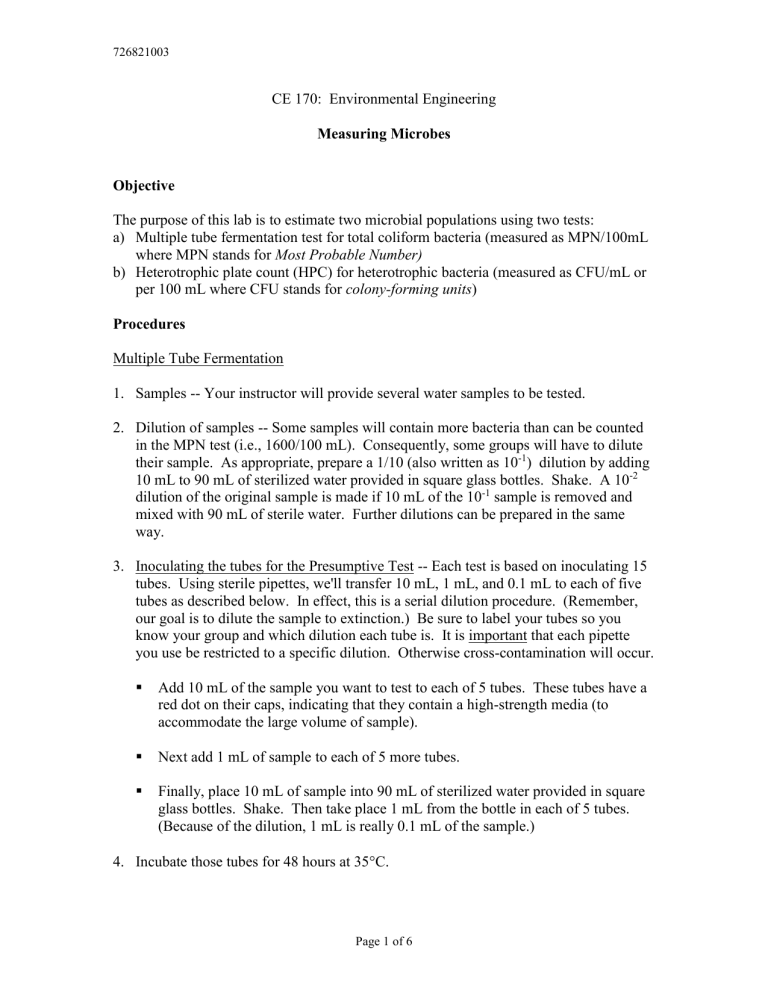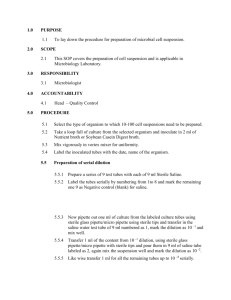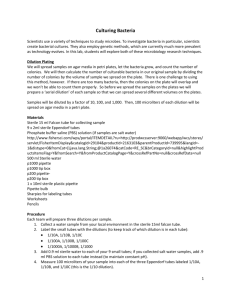CE 142L: Environmental Quality Laboratory

726821003
CE 170: Environmental Engineering
Measuring Microbes
Objective
The purpose of this lab is to estimate two microbial populations using two tests: a) Multiple tube fermentation test for total coliform bacteria (measured as MPN/100mL where MPN stands for Most Probable Number) b) Heterotrophic plate count (HPC) for heterotrophic bacteria (measured as CFU/mL or per 100 mL where CFU stands for colony-forming units )
Procedures
Multiple Tube Fermentation
1.
Samples -- Your instructor will provide several water samples to be tested.
2.
Dilution of samples -- Some samples will contain more bacteria than can be counted in the MPN test (i.e., 1600/100 mL). Consequently, some groups will have to dilute their sample. As appropriate, prepare a 1/10 (also written as 10
-1
) dilution by adding
10 mL to 90 mL of sterilized water provided in square glass bottles. Shake. A 10 -2 dilution of the original sample is made if 10 mL of the 10
-1
sample is removed and mixed with 90 mL of sterile water. Further dilutions can be prepared in the same way.
3.
Inoculating the tubes for the Presumptive Test -- Each test is based on inoculating 15 tubes. Using sterile pipettes, we'll transfer 10 mL, 1 mL, and 0.1 mL to each of five tubes as described below. In effect, this is a serial dilution procedure. (Remember, our goal is to dilute the sample to extinction.) Be sure to label your tubes so you know your group and which dilution each tube is. It is important that each pipette you use be restricted to a specific dilution. Otherwise cross-contamination will occur.
Add 10 mL of the sample you want to test to each of 5 tubes. These tubes have a red dot on their caps, indicating that they contain a high-strength media (to accommodate the large volume of sample).
Next add 1 mL of sample to each of 5 more tubes.
Finally, place 10 mL of sample into 90 mL of sterilized water provided in square glass bottles. Shake. Then take place 1 mL from the bottle in each of 5 tubes.
(Because of the dilution, 1 mL is really 0.1 mL of the sample.)
4.
Incubate those tubes for 48 hours at 35
C.
Page 1 of 6
726821003
5.
Reading the Presumptive Test -- After incubation, check the tubes for the presence of gas in the inverted tube. Record your results ("+" for the presence of gas and "-" for the absence of gas).
6.
Inoculating Tubes for the Confirmed Test -- Using sterile technique (as demonstrated by your instructor), sterilize a wire loop in a flame and transfer a drop of broth for each positive tube to a brilliant green lactose bile (BGLB) broth tube. Discard the used lauryl tryptose tubes as directed.
7.
Incubate the BGLB tubes for 48 hours at 35
C.
8.
Reading the Confirmed Test -- After incubation, check the tubes for the presence of gas in the inverted tube. Record your results as before. Discard the used BGLB tubes as directed.
Heterotrophic Plate Count (Pour Plate Method)
The HPC test is based on diluting the sample until it contains bacteria that will produce between 30 and 300 colonies on a plate.
1.
Using a sterile pipette, transfer 1.0 mL of the sample water (or diluted sample water) to a sterile Petri dish. Using the same pipette, transfer 10 mL of the sample water to a sterile dilution bottle, containing 90 mL of prepared dilution water.
2.
Using a second pipette, transfer 1 mL of the diluted sample water to a second sterile
Petri dish. Using the same pipette, transfer 10 mL of the sample water to another sterile dilution bottle, containing 90 mL of prepared dilution water.
3.
Using a third sterile pipette, transfer 1 mL from the dilution bottle to a third sterile
Petri dish.
4.
Pouring the plates -- Your instructor will prepare a flask of sterilized R2A agar.
When it is cooled to 40 to 45
C, lift the lid of each Petri dish in turn, pour enough agar onto the plate to cover about two-thirds of the surface, and immediately swirl the plate to spread the water sample throughout the agar. Pour a fourth Petri dish without a water sample as a control. Note that the three sample Petri dishes contain 1.0, 0.1, and 0.01 mL of water sample respectively.
5.
Incubate the plates upside down at 35
C for 48 hours.
6.
Counting the colonies -- After incubation, using a Quebec colony counter, count and record the total number of colonies on each plate according to Section 8, Part 907,
Standard Methods (attached). From these data, estimate the total number of bacterial colonies per 100 mL of water sample.
Page 2 of 6
726821003
Schedule
Unfortunately, bacteria take longer to grow than one lab period, so we'll have to periodically check on them as the week progresses. The schedule for reading various test results is shown below. It isn't necessary for everyone to attend all the sessions. Only one representative from each lab group is needed. If you are reasonably prepared, the data-reading sessions will take less than an hour each.
Tuesday Lab Section Wednesday Lab Section Thursday Lab Section
Tues
Wed
Start presumptive test
Start presumptive test
Thurs Read presumptive test.
Start confirmed test.
Fri
Sat Read the confirmed test.
Read presumptive test.
Start confirmed test.
Read the HPC test.
Sun
Mon
Start presumptive test
Read presumptive test.
Start confirmed test.
Read the HPC test.
Read the confirmed test.
Read the confirmed test.
Data Analysis
MPN Test
Estimate the number of coliform organisms in your sample by looking up the correct combination of positive tubes and noting Most Probable Number (MPN) and the lower and upper limits of the 95 % confidence interval. If you cannot find your configuration of positive tubes in the table, you have a combination that is statistically unlikely. You can estimate your MPN value using Thomas' formula:
MPN/100 mL
no.
of positive tubes
100 mL sample in negative tubes
mL sample in all tubes
If you diluted your sample before the test, don't forget scale-up your result to reflect the bacterial count of the original water sample.
HPC Test
Calculate the number of heterotrophic bacteria from the plate count. If you diluted your sample before the test, don't forget scale-up your result to reflect the bacterial count of the original water sample.
Page 3 of 6
726821003
Counting and Recording Number of Organisms
(Excerpt from Standard Methods, 16th Ed, 1985, Sec. 907-8, p.862)
Pour and Spread Plates:
Count all colonies on selected plates promptly after incubation. If counting must be delayed temporarily, store plates at 5 to 10
C for no more than 24 hours, but avoid this as routine practice. Record the results of sterility controls on the report for each lot of samples.
Use an approved counting aid such as the Quebec colony counter, for manual counting.
In preparing plates, plant sample volumes that will give from 30 to 300 colonies/plate.
The aim is to have at least one dilution which will give colony counts between these units, except as provided below.
When the total number of colonies developing from 1.0 mL is less than 30, disregard the rule above, and record the results observed. With this exception, consider only plates having 30 to 300 colonies in determining the plate count. Compute bacterial count per milliliter by multiplying average number of colonies per plate by the reciprocal of the dilution used. Report counts as "colony-forming units" (CFU) per milliliter.
If there are no plates with 30 t0 300 colonies, and one or more plates have more than 300 colonies, use the plate(s) having a count nearest 300 colonies. Compute the count by multiplying average count per plate by the reciprocal of the dilution used and report as
"estimated colony-forming units" per milliliter.
If plates from all dilutions of any sample have no colonies, report the count as less than 1
(<1) times the reciprocal of the corresponding lowest dilution. For example, if no colonies develop on the 1:100 dilution, report the count as less than 100 (<100) estimated colony-forming units per mL.
If the number of colonies per plate far exceeds 300, do not report results as "too numerous to count" (TNTC). If there are fewer than 10 colonies/cm 2 , count colonies in
13 squares (of the colony counter) having representative colony distribution. If possible, select seven consecutive squares horizontally across the plate and six consecutive squares vertically, being careful not to count a square more than once. Multiply the sum of the number of colonies in 13 representative square centimeters by 5 to compute estimated colonies per plate when the plate area is 65 cm
2
. When there are more than 10 colonies/cm
2
, count four representative squares, take average count per square centimeter, and multiply by the appropriate factor to estimate colonies per plate. The factor is 57 for disposable plastic plates, and 65 for glass plates. When bacterial counts on crowded plates are greater than 100 colonies/cm
2
, report result as greater than (>)
6500 times the reciprocal of the highest dilution plated for glass plates or greater than (>)
5700 times the reciprocal for plastic plates.
Page 4 of 6
726821003
Report as "estimated colony forming units per milliliter".
If spreading colonies (spreaders) are encountered on the plates selected, count colonies on representative portions only when (a) colonies are well distributed in spreader-free areas, and (b) the area covered by the spreader(s) does nor exceed one-half the plate area.
Count as individual colonies similar-appearing colonies growing in close proximity but not touching, provided that the distance between them is at least equal to the diameter of the smallest colony. Count impinging colonies that differ in appearance, such as morphology or color, as individual colonies.
If plates have excessive spreader growth, report as "spreaders" (Spr). When plates are uncountable because of missed dilution, accidental dropping and contamination, or the control plates indicate that the medium or other material or labware was contaminated, report as "laboratory accident" (LA).
Page 5 of 6
726821003
MPN index and 95% confidence limits for various combinations of positive results when five tubes are used per dilution (10 mL, 1.0 mL, 0.1 mL)
95%
Confidence
95%
Confidence
Combination of Positives
MPN
Index /100 mL
Limits
Lower Upper Combination of Positives
MPN
Index /100 mL
Limits
Lower Upper
0-0-0
0-0-1
0-0-1
0-2-0
<2
2
2
4
- -
1.0 10
1.0 10
1.0 13
4-2-0
4-2-1
4-3-0
4-3-1
4-4-0
22
26
27
33
34
9.0 56
12 65
12
15
16
67
77
80
1-0-0
1-0-1
1-1-0
1-1-1
1-2-0
2-0-0
2-0-1
2-1-0
2-1-1
2-2-0
2-3-0
3-0-0
3-0-1
3-1-0
3-1-1
3-2-0
3-2-1
4
7
7
9
9
12
2
4
4
6
6
8
11
11
14
14
17
4-0-0
4-0-1
4-1-0
4-1-1
4-1-2
13
17
17
21
26
5.0 38
7.0 45
7.0 46
9.0 55
12 63
Taken from Standard Methods, 1989 edition .
1.0 11
1.0 15
1.0 15
2.0 18
2.0 18
1.0 17
2.0 20
2.0 21
3.0 24
3.0 25
5.0 29
3.0 24
4.0 29
4.0 29
6.0 35
6.0 35
7.0 40
5-3-3
5-4-0
5-4-1
5-4-2
5-4-3
5-4-4
5-5-0
5-5-1
5-5-2
5-5-3
5-5-4
5-5-5
5-0-0
5-0-1
5-0-2
5-1-0
5-1-1
5-1-2
5-2-0
5-2-1
5-2-2
5-3-0
5-3-1
5-3-2
170
130
170
220
280
350
240
300
500
900
1600
1600
50
70
90
80
110
140
23
30
40
30
50
60
100
100
200
300
-
600
80
50
70
100
120
160
20
30
40
30
40
60
9.0 86
10 110
20
10
140
120
20
30
150
180
170
210
250
250
300
360
410
390
480
580
690
820
940
1300
2000
2900
5300
-
Page 6 of 6








